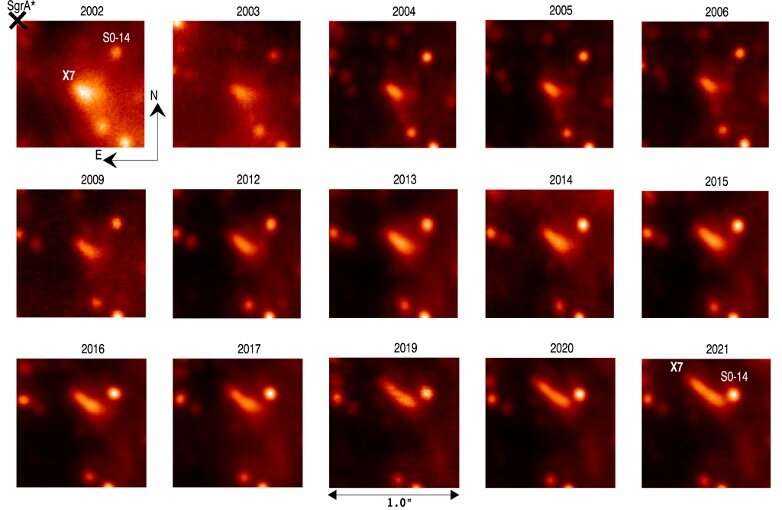Two decades of monitoring from W. M. Keck Observatory on Mauna Kea in Hawaiʻi reveals a peculiar cloud dubbed X7 being pulled apart as it accelerates toward the supermassive black hole at the center of our Milky Way galaxy.
Astronomers from the UCLA Galactic Center Orbits Initiative (GCOI) and Keck Observatory have been tracking the evolution of this dusty gas filament since 2002; high-angular resolution near-infrared images captured with Keck Observatory’s powerful adaptive optics system show X7 has become so elongated that it now has a length of 3,000 times the distance between the Earth and sun (or 3,000 astronomical units).
The study is published in today’s issue of The Astrophysical Journal.
“This is a unique chance at observing the effects of the black hole’s tidal forces at high-resolution, giving us insight into the physics of the Galactic Center’s extreme environment,” said Anna Ciurlo, a UCLA assistant researcher and lead author of the study.
Tidal forces are the gravitational pull that stretch an object approaching a black hole; the side of the object closest to the black hole is pulled much more strongly than the side farthest away.
“It’s exciting to see significant changes of X7’s shape and dynamics in such great detail over a relatively short time scale as the gravitational forces of the supermassive black hole at the center of the Milky Way influences this object,” said co-author Randy Campbell, science operations lead at Keck Observatory.
X7 has a mass of about 50 Earths and is on an orbital path around our galaxy’s black hole, called Sagittarius A* (or Sgr A*), that would take 170 years to complete.
“We anticipate the strong tidal forces exerted by the Galactic black hole will ultimately tear X7 apart before it completes even one orbit,” said co-author Mark Morris, UCLA professor of physics and astronomy.
Based on its trajectory, the team estimates X7 will make its closest approach to Sgr A* around the year 2036, then dissipate completely soon after. The gas and dust constituting X7 will eventually get dragged toward Sgr A* and may later cause some fireworks as it heats up and spirals into the black hole.
These findings are the first estimate of X7’s mildly eccentric orbital path and most robust analysis to date of the remarkable changes to its appearance, shape, and behavior. To observe X7, the team used Keck Observatory’s OH-Suppressing Infrared Imaging Spectrograph (OSIRIS) and Near-Infrared Camera, second generation (NIRC2), in combination with the adaptive optics systems on the Keck I and Keck II telescopes.
X7 shows some of the same observational properties as the other strange dusty objects orbiting Sgr A* called G objects, which look like gas but behave like stars. However, X7’s shape and velocity structure has morphed more dramatically compared to the G objects. The stretched-out gas and dust filament moves rapidly, clocking in at speeds of up to 490 miles per second. Because of the extremely large mass of the black hole, everything in its vicinity moves much faster than we typically see anywhere else in our galaxy.

Images captured with Keck Observatory’s NIRC2 instrument and adaptive optics showing X7’s evolution between 2002-2021. © A. Ciurlo et al. / UCLA GCOI / W. M. Keck Observatory
Though X7’s origin is still a secret waiting to be unlocked and confirmed, the research team does have some clues about its possible formation.
“One possibility is that X7’s gas and dust were ejected at the moment when two stars merged,” said Ciurlo. “In this process, the merged star is hidden inside a shell of dust and gas, which might fit the description of the G objects. And the ejected gas perhaps produced X7-like objects.”
The research team will continue to monitor the dramatic changes of X7 with Keck Observatory as the power of the black hole’s gravity yanks it apart.
“It’s a privilege to be able to study the extreme environment at the center of our galaxy,” said Campbell. “This study can only be done using Keck’s superb capabilities and performed at the revered Maunakea, with honor and respect for this special site.”
More information:
Anna Ciurlo et al, The Swansong of the Galactic Center Source X7: An Extreme Example of Tidal Evolution near the Supermassive Black Hole, The Astrophysical Journal (2023). DOI: 10.3847/1538-4357/acb344
Provided by
W. M. Keck Observatory
Citation:
The swan song of a cloud approaching the Milky Way’s supermassive black hole (2023, February 21)



